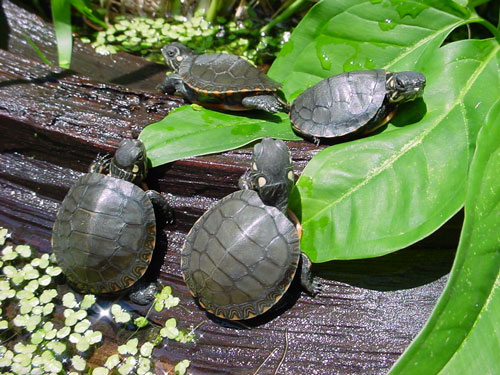Expert tips on keeping aquatic turtles.
While it should go without saying that hand washing is important and should be common practice for good health and hygiene, it cannot be overemphasized. And it's not just important to do after handling your turtles, but before handling them as well. Salmonellosis is commonly associated with turtles, other reptiles and poultry, and it can be transmitted to humans by these animals. But studies have shown that the disease is not passed vertically from parent to offspring via the egg, so baby turtles do not hatch with the bacterial organism itself. This means that they have to receive it from another source. And this means that you could actually give your turtle salmonellosis! While it generally doesn't cause the turtle any problems or make them sick, the disease can proliferate to the point that they can give it back to you, making you very sick (and giving pet turtles a bad name!) in the process. So, wash your hands!

Photo by Paul Vander Schouw
Eastern painted turtles love to bask, and will do so in groups even as hatchlings.
2. Don't Handle Your Turtle Except By Necessity
Yes, baby turtles – well, maybe all turtles – can be cute. But they are not puppies and kittens, and they should not be handled unless there is a specific reason for doing so. Turtles are not domesticated animals by any definition, nor are they mammals or even birds, which do possess the concept of affection. The brain of a turtle does not even possess the structure associated with affection, so although they may act like they are glad to see you and want to be handled, most likely they are just expecting to be fed. Handling can cause undue stress to the turtle, and subject both it and you to infectious diseases that are best avoided. Limit handling to periodic health checks, when maintenance of the turtle's habitat is required, or in an emergency situation. Turtles are best treated like tropical fish -observed doing their thing in their tank, and not flopping about frantically in your hand or on the floor.
3. Keep your turtle's water clean
You (hopefully) wash your clothes, change your sheets and keep your own home clean. The least you can do for your turtle is to keep its home clean, too, by providing a filter or performing frequent water changes. There are numerous systems available commercially that are designed to provide mechanical, biological and chemical filtration, and some even provide a combination of two or all three functions. Good filters are often not cheap, but the cost usually outweighs the alternative of weekly or even daily water changes. Hygiene will play an enormous role in keeping your turtle (and you) healthy.
4. Provide the proper captive habitat
Box turtles need a terrarium with a water dish for soaking, but a cooter or slider would waste away and die under similar conditions. Although many species have similar housing requirements, pond turtles have very different needs than mud turtles, which have very different needs than box turtles, etc. Do your homework and research what type of environment your turtle will need – ideally before you actually get the turtle – so that you can be sure to provide it with the most appropriate home possible. Find out if your turtle will prefer fully aquatic, fully terrestrial or something in between. Will your turtle like to spend a lot of time basking, or would it rather hide under a rock all day long? Will it like a deep tank and swim freely, or will it prefer to trudge around on the bottom and simply extend its neck to reach the surface to breathe? These are all critically important determinations to make in order to be sure you provide a suitable home for your turtle.
5. Provide the proper diet For Your Turtle
Some turtles are highly carnivorous while others are strictly vegetarian, and still others enjoy a diet that combines elements of both. Although many commercial turtle diets are entirely adequate as a staple food source, some turtle species simply refuse to eat pellets. Just as there are many different types of protein sources, from fish and crickets to earthworms and pinky mice, there are just as many different types of fruit and vegetable, from kale and squash to cantaloupe and endive. Researching what type of diet your turtle is likely to prefer, and provide a broad variety within that diet. This will help ensure that all of your turtle's nutritional requirements are met. As with any organism, malnutrition can lead to a whole host of health and wellness problems, so be sure your turtle is not languishing on lettuce when it would rather be feasting on fish!


